Like many great debates, there was no firm answer - until now. During the Rivers' most recent rehab at Disneyland, Disney Imagineers made some changes around the riverbed and have declared that the Rivers of America now depict four distinct zones:
A little over a week ago, I spoke with Imagineer Kim Irvine and asked her to talk us through the new Rivers of America, noting what Disneyland visitors might find different about it than before.
Kim Irvine: "On the rivers in the past, the plant material has grown in and naturalized itself. So it had lost the character of the original that Bill Evans and the landscapers had planned for it. So our first plan was to re-landscape the river.
"Then we thought, if we're going to do that, why not give the rivers specific names and develop the landscaping for each one of those regions. So as we move around the rivers, you can experience different climates, different colors and different plan palettes.
"With the animals, I always like to look back at the original designers. Marc Davis and Sam McKim did so much great work on the Rivers of America. When Disneyland got started, they had just finished working on those wonderful True Life Adventure films, so they had a lot of experience with how animals behaved in nature, from working on those films. Marc was such a great animator, he could create scenes that required no words. You could look at the animals, and the positions they were in, and know exactly what was happening at that time.
"For instance, the deer were in positions that you would find them if you came across them in nature. They were drinking from the water, or grazing on grass, and then they hear this big boat coming through the water. Of course, they would look up in that startled moment before they would run.
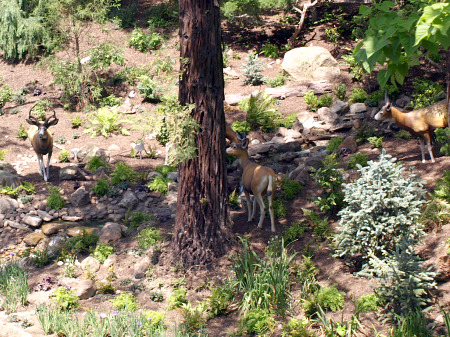
"A lot of our animals through the last 50 years had been scattered around the river, and not so much in herds anymore - a moose here and a deer there and an elk over there - so we put them back together in herds. We even added a stream for the deer to be drinking from, because there was no stream before, and we didn't think it'd be quite as interesting if they were all just standing along the edge of the river.
"We couldn't put the burning cabin back, but we wanted to make it something more interesting than the pioneer cabin that it had become as of late. We also had this wonderful asset of the old keelboat that we hadn't wanted to give up. We decided to make the cabin Mike Fink's cabin. Even though he might not be a a character that many kids know today, why not make him a relevant character? So we dressed up his keelboat out in front and made a lookout in what used to be the eagle's tree. We put a big campfire out in front and now we've got him and Davy Crockett and George Russell inside arguing about who is king of the river. There's a great audio track so you can hear them in there boasting about all the things they know how to do better than the others. [Note from Robert: You can hear that audio best from the island. Just walk around the fort on the Tom Sawyer Island pathway to the cabin site.]
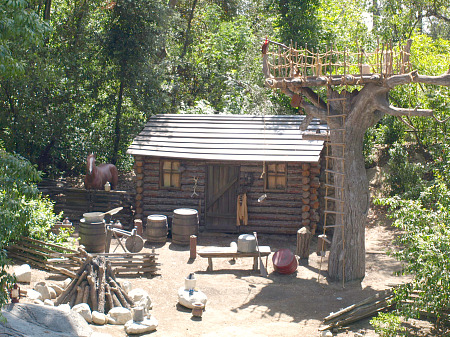
"The Indian village now has, in addition to two Indian scouts that see you before you get to the Indian chief, the village now had a horse corral behind it, a very natural look like the Indians may have made out of birch branches and such. We have real pinto ponies back there behind the village. In the village itself, we've made and painted all-new teepees, and switched it up so it has a new look to it.
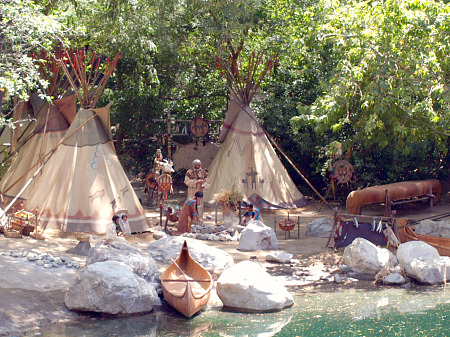
"The mother eagle is now with here babies up in the tree, the one that used to be back at the cabin has now found a new home over in our Potomac area. And we have some new mountain lions in the Rio Grande area.
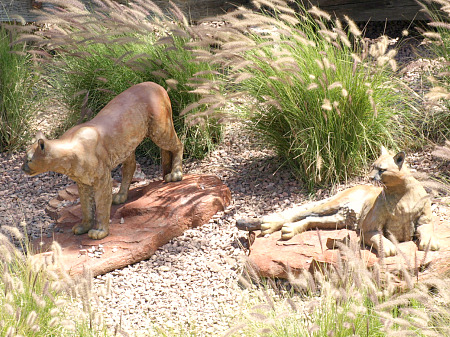
"So let me talk about the different zones. There's the Mississippi, of course, where we have a lot of willows and taxodiums - all very gray/green and droopy. Then you move into the Columbia, which is very much the Pacific Northwest - dark, dark, rich brown soil with lots of firs and pines and redwoods. And there will be rich ground cover, violets and ferns that will look spectacular once it grows in.
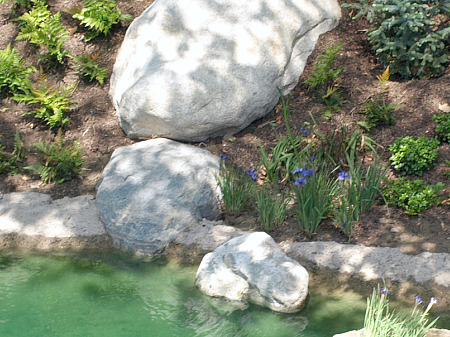
"Then it moves into the Potomac, where our Indians are. That is done in birches and trees that change color, and not just in the fall, they change constantly color throughout the year. And then we go into the Rio Grande, which is the backdrop to Big Thunder Mountain, so it's all in hot reds and oranges and lots of grasses, manzanita and high-desert-type of landscape.
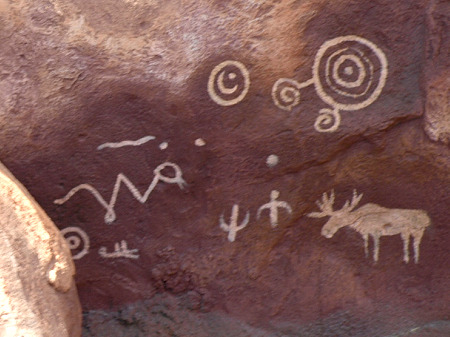
"We painted the shorelines; we painted the rocks; we made an effort to make each area stand out on its own."
Robert: Why these four rivers? Why not the Ohio or the Colorado?
Kim Irvine: "Well, the Rio Grande and the Mississippi were obvious for us. For the other two, we thought about the landscaping that was already there. We had some beautiful backbone trees that were still there from Bill's day. It's hard to believe when you are sailing around that river on the Columbia, thinking "I'm in Anaheim," but there are some trees out there that are over 90 feet tall. So they set the backdrop for us. The Columbia [area] already had some nice pines and fir trees in it. The Potomac already had some great sycamore and large birches - they kind of things that you would find in that region.
"There was a lot of debate! We sat in the conference room with Tony [Baxter] for several hours looking at maps of all the rivers of America, trying to decide."
Kim also said that the spiel now playing on the Sailing Ship Columbia is a temporary one, and that new spiels, with additional details about the river's changes, are coming to the Columbia, the Mark Twain Riverboat and Davy Crockett's Explorer Canoes.
So will the same changes come to the Rivers of America at Florida's Magic Kingdom? There are no plans yet, Kim said.
But she added:
"You never know. We had a lot of the Disney World people out here during the downtime, just by coincidence, and we walked it with them, so you never know."
Tweet
I would also love to hear some of the details about the changes that were scrapped from the Imagineer's plans. Apparently Mr. Baxter had much bigger ideas for this refurb many of which were victim to budgetary restrictions and other cost cutting measures. Did you happen to glean any insights in that regard, Mr. Niles?
This article has been archived and is no longer accepting comments.